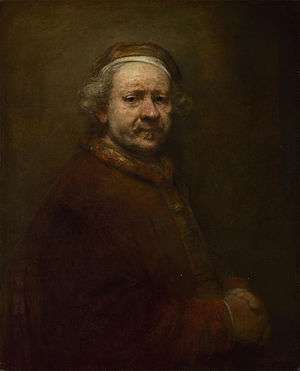Self-Portrait at Seventy-Eight (Ingres)
_-_Zelfportret_(1864)_-_28-02-2010_13-37-05.jpg)
Self-Portrait at Seventy-Eight is an 1858 oil-on-canvas painting by the French Neoclassical artist Jean-Auguste-Dominique Ingres. It is the last of his many portraits, which he had anyway deemed distracting to his true calling with History painting.
It is renowned for its honest treatment of the physical effects of old age, and the inevitability of decay and death. His expression is foreboding and intense, and he is tightly wrapped in stiff military like clothes. Ingres was to live a further nine years, dying on 14 January 1867, aged 86.
The irony of Ingres' career is that it is the portraits for which he became most renowned, in demand, and is best remembered by. This self-portrait was painted at a point when Ingres, owing to age, could no longer commit to further society portraits, which typically took him 4-5 years to complete.
Description
The self-portrait is brutally honest and mostly bereft of vanity; as a study of old age it goes beyond even his Portrait of Monsieur Bertin which he deliberately invokes. He took Raphael and late self-portraits by Rembrandt as influences.

Ingres presents himself in half bust view, dressed in clothing that suggest a cultivated, rich, well traveled and influential man. He is slimmer in the painting than he was in real life at the time, and wears an evening dress uniform that reflects his status as grand officer in Napoleon's Legion of Honour.[1] Although Ingres appears aged and troubled, the portrait contains hints of optimism; he had been widowed but had recovered and was happily married to his second wife Dominique Rame, and could look back on a commercially successful if not artistically fulfilling career.[2] He gives himself a grim expression, with a down turned mouth, which art historians view as overstating his existential view – extant photographs from the period show him almost, or about to smile, and his letters from this period reflect a degree of contentment.[3]
His expression is often interpreted by modern art historians as conflicted, troubled and bad tempered, the reflection of a frustrated history painted at the end of a career spent largely on society painting.[3]
The painting was widely praised when first exhibited, and is today considered one of the finest examples of self-portraiture in art history. It is often compared to Rembrandt's later self-portraits, although Ingres's work contains hints of vanity that the older master's did not; Ingres has smoothed out his skin and has more and darker grey hair than contemporary photographs suggest.[3]
At some point during this work's creation, Ingres also sketched another self-portrait, which was intended as a pendant for his Portrait of Madame Ingres, depicting his second wife. However that self-portrait was abandoned. The current work was likely completed with the assistance of unidentified collaborators, though the passages describing his face can only have come from his hand.[3]
Notes
Sources
- Finberg, A. J. Ingres. London, ISBN 978-1-5327-0047-7
- Rosenblum, Robert. Ingres. London: Harry N. Abrams, 1990. ISBN 978-0-300-08653-9
- Conisbee, Philip. Portraits by Ingres: Image of an Epoch. New York: Metropolitan Museum of Art, 1999. ISBN 978-0-300-08653-9